Miniature Medals 약장
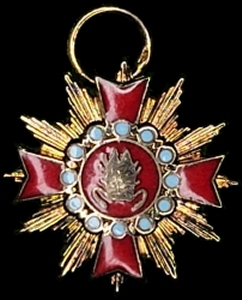
Some Korean Orders and medals are available as miniature medals, Yak Jang 약장. Korean law requires miniature Medals to be ½ of their normal size, and expressly prohibits miniaturizing Orders that are normally worn on a sash or cravat. During the 1950s, most Korea Orders and Medals were breast medals. Miniatures from this time can be found, but starting in the early 60s, Sashes and Cravats were added to the higher classes. Korean legislation also prohibits the wearing of full-sized orders on a sash or cravat while wearing miniature medals of the lower classes. In general, only the 4th and 5th classes of an Order, Merit Medals and Ki Jang can be miniaturized. Because of these prohibitions, miniature medals are rarely found after the 1950s. High ranking military officers and civil servants want to wear their most prestigious orders at formal events, so miniatures are usually not needed by the recipients.
All that being said, there is an exception. Miniature Breast Stars are known to exist because there are situations where Korean diplomats and high-ranking Korean military officers need to wear miniatures to conform with the other attendees of an event, and in these situations, miniatures have been manufactured, even though they violate the legal codes. Interesting enough, even though illegal, miniature breast stars are available from the Korean government. Also, keep in mind that Korean legal restrictions do not apply to foreigners.
A couple of interesting footnotes:
Korean legislation gives Korean Awards precedence over foreign decorations. However, it is not unusual to find Korean groups or ribbon bars where the assemblage is done by the relative importance of the individual medals, regardless of the award’s origin. In the example below and to the left, the U.S. Bronze Star has been mounted by its relative importance between the Orders of Military Merit and the Defense Merit Medal. In the center group below, the United Nations medal is placed last after all the Korean medals, as required by Korean Law. If it had been mounted by its relative importance, it would be after the Korean War Medal. The same is true for the third group below. The U.S. Legion of Merit is placed last, however in this case, there are no medals of lower importance, only higher.
The Korean phrase “Yak Jang” 약장 is used for “Miniature Medal” and for “Ribbon Bar” but translation programs usually render it as “Medicine Chest” or “Medicine Cabinet”. On a few rare occasions, it is rendered as deshabille or dishabille, a French term referring to the state of being dressed in a casual or careless style.
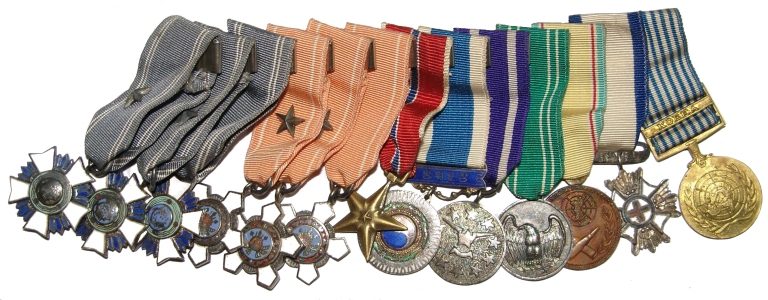
Order of Military Merit, Chungmu w/Silver Star
Order of Military Merit, Chungmu w/Silver Star
Order of Military Merit, Chungmu
Order of Military Merit, Hwarang w/Silver Star
Order of Military Merit, Hwarang w/Silver Star
Order of Military Merit, Hwarang
United States Bronze Star
Defense Merit Medal
10th Anniversary of the Military Founding
Guerilla Warfare Service Medal
Korean War Service Medal
Red Cross Membership Medal, Silver Class
United Nations Medal for Korea
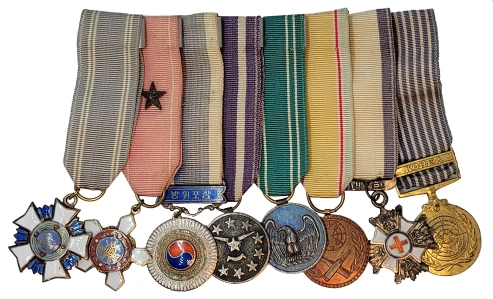
Order of Military Merit, Chungmu
Order of Military Merit, Hwarang with Gold Star
Defense Merit Medal
10-year Anniversary of the Military Founding
Guerilla Warfare Service Medal
Korean War Service Medal
Red Cross Membership Medal, Silver Class
United Nations Medal for Korea
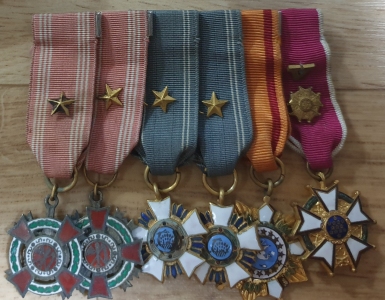
Order of Military Merit, Ulchi w/Gold Star
Order of Military Merit, Ulchi w/Gold Star
Order of Military Merit, Chungmu w/Gold Star
Order of Military Merit, Chungmu w/ Gold Star
Order of Service Merit, 5th Class but with a 1973 ribbon
U.S. Legion of Merit, Officer Degree (3rd Class)
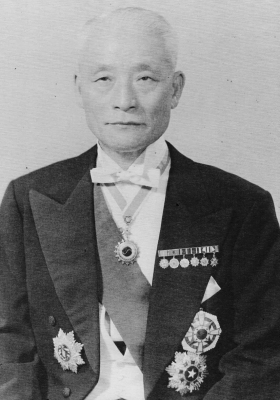
Kim Hong-Il 김흥일 (金弘壹 1898-1980)
Kim Hong-Il was born in Korea and was briefly a teacher. He was arrested and imprisoned by a Japanese gendarmerie. After his release, and not wanting to live under Japanese rule, he defected to the Republic of China. He graduated from the Chinese Republican Guizhou Military Academy in January 1921, and was commissioned as a second lieutenant. In 1939, he was promoted to Major General of the Chinese Central Army, which made him the first Korean to become a general in the Chinese Republican Army. In April 1945, he switched his allegiance and became the Chief of Staff, of the Korean Liberation Army Command. After World War II, he switched again and returned to the Chinese Army and was appointed a Major General (Nov. 1945). He later switched again and returned to Korea, enlisted in the Korean military (Dec. 1948) and was appointed as a Brigadier General. This made him the first general appointed after the founding of the Korean army on Aug 15, 1948. He retired as a Lieutenant General on Mar. 20, 1951. He then served as the Korean ambassador to the Republic of China from 1951 to 1961, became the Korean Minister of Foreign Affairs in May 1961 and later served as the 9th President of the Korean Veterans Association 대한민국재향군인회 (大韓民國在鄕軍人會)(Dec. 1961).
His Awards from Korea include: the Order of Military Merit, Chungmu (Dec. 30, 1950), the Order of Military Merit, Taeguk (July 26, 1951), the Order of Civil Merit, Blue Stripes (Jan. 1, 1960), the Order of Merit for National Foundation, Independence Class (Mar. 1, 1962) and the Order of Civil Merit, Mugunghwa Class (Aug. 11, 1980).
From the Republic of China, he received: the Meritorious Service Medal for the Jinan Operation 제남작전유공 (濟南作戰有功) (1928), the Mangaryeong Rotary Meritorious Service Medal 만가령 회전 유공훈장 (萬⊙領會戰有功受大功勳章) (1938), the Hwaju Honorary Medal for the Exclusive Supervision of the Sango Association 상고회전 전용감수 화주영예훈장 (上高會戰⊙戰勇敢受華胄榮譽勳章) (1941), the Chinese Anti-Japanese War Commemorative Medal 중국항일전쟁기념훈장 (中國抗戰有功受勝利勳章) 및 항전기념장 (抗戰記念章) (1945), the First Class Commander of the Northwest Territories, Air Force, Army and Navy 서북시가전유공육해군일등장장 (四平街戰功作戰有功受陸海軍一等奬章) (1946), the Loyalty and Diligence Medal 충근 (忠勤), The Order of the Resplendent Banner 대수운마 (大綬雲摩) and The Order of the Brilliant Star 대수경성 (大綬景星).
